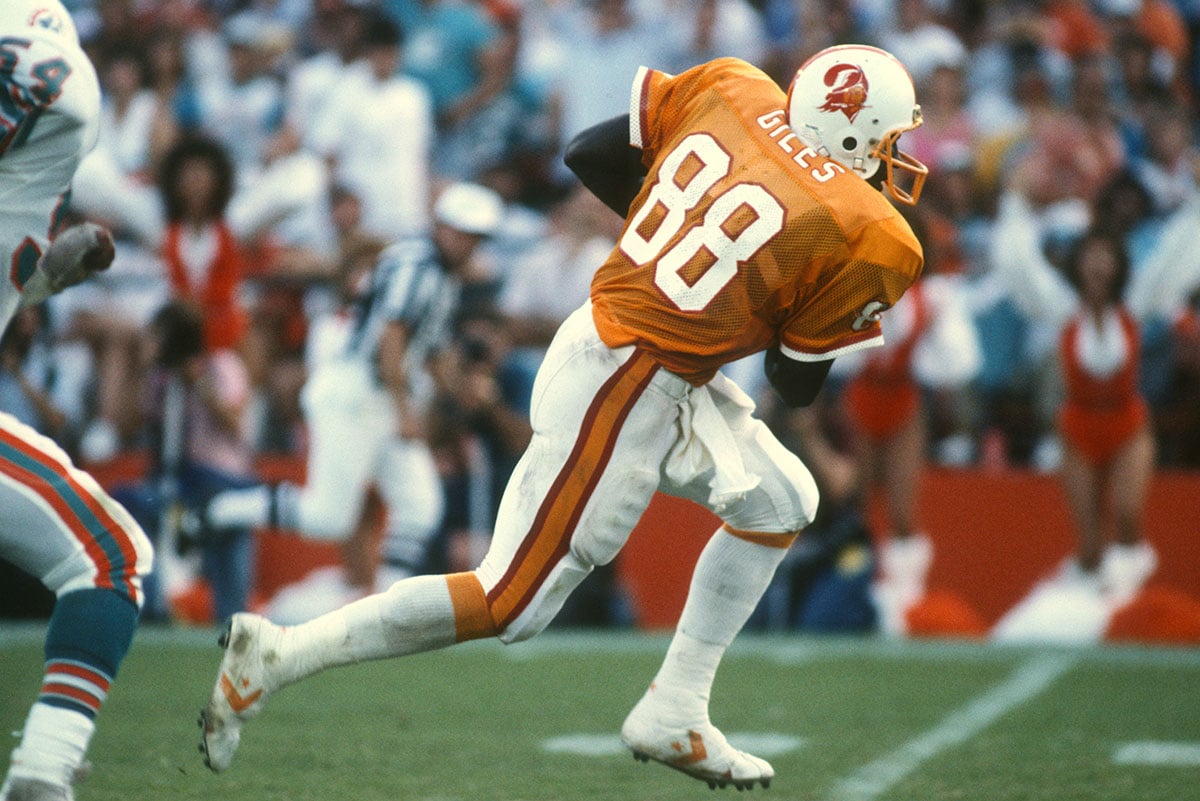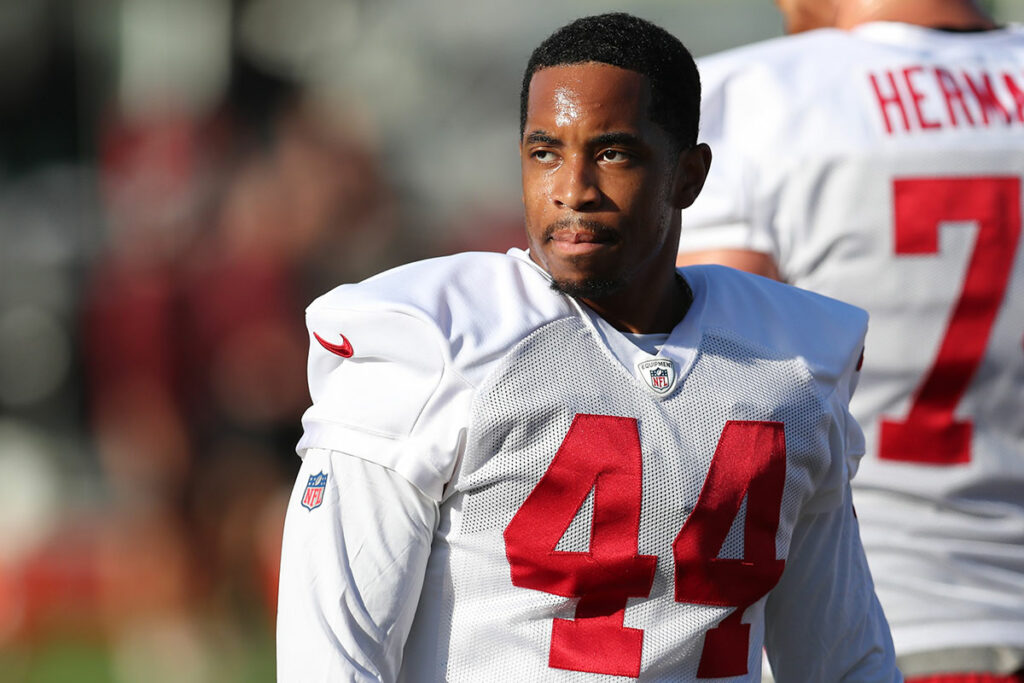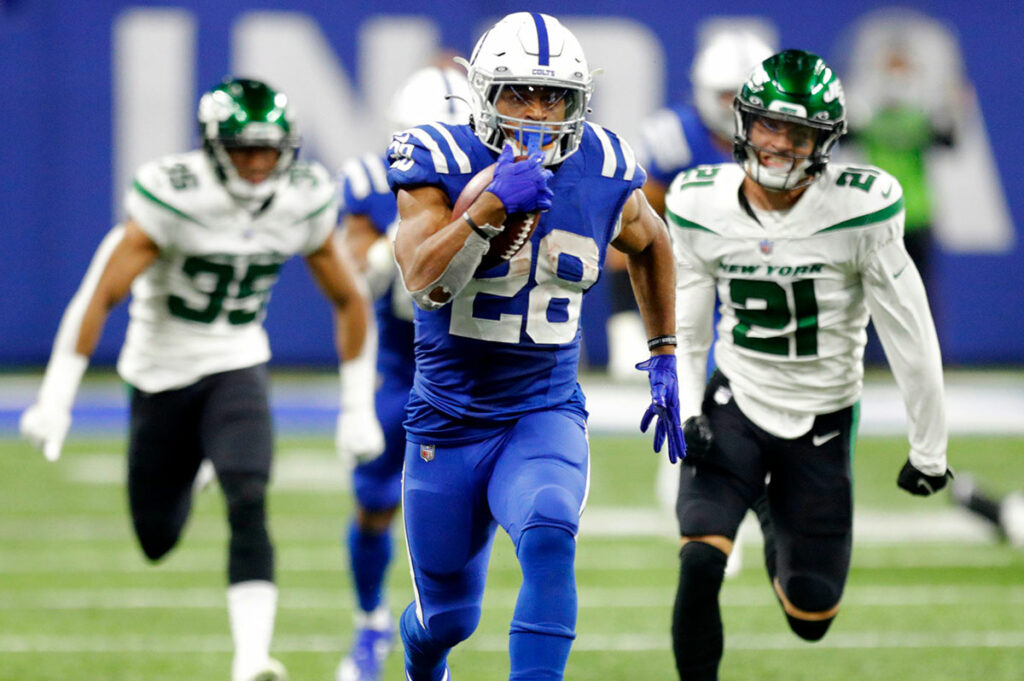When fans think of the Buccaneers, most, if not all, recall the Super Bowl-winning teams of 2002 and 2020. Anytime before that is generally seen as a dark era of Bucs football filled with a lot of losing seasons. Even with that caveat, plenty of players shined with impressive years and stints. Players that are largely forgotten in the minds of fans, apart from the most ardent and hardcore supporters.
For this series, I wanted to take a look at players who are underrated or not mentioned much when discussing the team’s history. The number of players mentioned in each entry will vary based on position.
The only rules are that they were Bucs between 1976 to 1996 – fitting the prerequisite of rocking the original “Bucco Bruce” uniforms – and are worth remembering.
Overview:
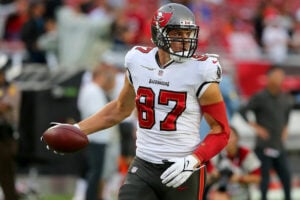
Bucs TE Rob Gronkowski – Photo by: Cliff Welch/PR
The Bucs’ history at the tight end position has been peculiar. While the franchise has lacked consistent high-end production from the position, a few notable names emerged from the group in the 2000s.
Kellen Winslow had a few productive seasons as Josh Freeman’s security blanket. Dallas Clark had a brief one-season cameo, although he was past his prime by the time he joined the team. Cameron Brate surpassed any and all expectations as an undrafted free agent, amassing 33 touchdowns over his nine years with the organization.
The biggest name of all was future Hall of Famer Rob Gronkowski. After enjoying one year of retirement, he joined forces with his old pal Tom Brady in 2020 to help lead the Bucs to a Super Bowl victory and spent two seasons calling Tampa Bay home.
While “Gronk” has been the highlight of the position in recent memory, other tight ends put together impressive resumes worth revisiting and stories needing retelling.
Forgotten Bucs At TE
1. Jimmie Giles
In terms of accolades and production with the team, there is no doubt Jimmie Giles is the best tight end in Buccaneers’ history. As with Doug Williams and James Wilder, plenty of fans have heard of him and know he was a bright spot on the 1980s teams. While his dominance came in an era when tight ends were not as prominent in the receiving game, his play deserves further recognition.
A look through his highlights does not do him justice when considering what perhaps could have been. After a brief stint in minor league baseball after being drafted by the Los Angeles Dodgers in the 12th round in 1976, Giles became an NFL player after Houston Oilers selected him in the third round in 1977. Let’s just say he made his home run plays in a different way.
After playing one season in Houston, he was traded to the Bucs in a package of picks for running back Earl Campbell, who quickly dominated the league. While Giles did not win an MVP award or become an All-Pro like Campbell, he quickly developed a rapport with quarterback Doug Williams.
By 1980 he was a Pro Bowl tight end, a distinction he would have four times. That season he had a knack for getting downfield, averaging 18.2 yards per catch. Playing at 6-foot-3 and 239 pounds, he often acted as an oversized wide receiver, which was a rarity at that time.
While the decade featured the likes of Ozzie Newsome, Kellen Winslow Sr., and Todd Christensen, Giles was right there with them in terms of talent.
An argument has been made that he had the potential to be among the best tight ends in NFL history. Former Bucs wide receiver Gerald Carter once stated Giles could have been “one of the best all-time tight ends, if [the Bucs had] used him more.”
A sample size of this belief was exemplified in 1985. His last full season with the team included a game for the ages. Against the Dolphins in Week 7, Giles had seven receptions for 116 yards with four touchdowns. Between weeks 7-9 that year, he had 12 receptions, seven resulting in touchdowns.
Despite his immense talent and games where he completely took over, one could look back and question – what if? While other elite tight ends got plenty of targets, Giles’ career-high in receptions was 45. For a couple of years, he spent more time blocking than being properly employed as a weapon. While he made the team’s Ring of Honor in 2011, there is an alternate world where he has a bust in Canton, Ohio.
In 2020, the Tampa Free Press made this argument, and a former NFL head coach and Hall of Famer agreed.
“To me, he was exceptional,” Bears legend Mike Singletary said then. “He was a receiver playing tight end. That is about as well as I can state it. He was a very good blocker. There is no reason he should not be in the Pro Football Hall of Fame. He is very deserving.”
This brief mini-documentary states his case.
2. Ron Hall
Following the footsteps of Jimmie Giles was a tall task, but the late Ron Hall did an adequate job for the Bucs, starting 90 games over seven years.
Hall was not a flashy player who lit up the box score, but he carved out a role on offense as a receiving threat, primarily as the third receiving option behind Mark Carrier and Bruce Hill.
While he only recorded 10 touchdowns in Tampa Bay, he had five seasons of 30 or more receptions. A couple of games that stick out in his career came against a team he would close his career out with for two seasons in 1994-1995 – the Lions.
In Week 2 of 1992, Hall recorded six receptions for 83 yards and a touchdown in a 27-23 win. The next season in Week 4, he tallied 59 yards on three receptions and a touchdown against the former NFC Central division rivals.
He made plenty of tough catches and fit the mold of an old-school tight end.
3. Dave Moore
Part of what makes Dave Moore worth mentioning is the unique career he had as a Buccaneer. A seventh-round pick by the Dolphins in the 1992 NFL Draft, Moore had no business playing in 220 games over 15 seasons. He did so playing in Tampa Bay for two stints between 1993-2001 and 2004-2006, bouncing between long snapper and tight end.
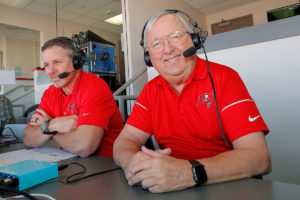
Dave Moore and Gene Deckerhoff – Photo courtesy of the Buccaneers
His first stint with the team included going from long snapper to fullback to becoming an option in the passing game for various Bucs quarterbacks, recording 24 touchdowns, many of them coming from quarterback Trent Dilfer in the late 1990s.
Moore established himself as a versatile contributor, from special teams, blocking, and serving as a red zone threat. Although he did not play for the Super Bowl team in 2002, he returned to Tampa Bay in 2004 for three seasons to wrap up his career.
While he did a little bit of everything throughout his playing days, this further extended after his retirement in 2007.
After an NFC Pro Bowl nod as a long snapper to go out on top, Moore quickly joined the iconic voice of Gene Deckerhoff in the Bucs’ broadcast booth. At the time of this announcement, Jon Gruden – his former head coach – had this to say about him.
“He was a professional football player,” Gruden said in 2007. “He’s versatile, he’s a team guy, he’s a consistent football player and he’s a good player. That’s why he played as long as he did. He’s able to do a lot of things and he’s able to do a lot of things well.”
Dave Moore continues to do things well, only now it is from the broadcast booth and not the playing field. His contributions in Tampa Bay are worth appreciation and acknowledgment as his name lives on for a new generation of football fans.
Adam Slivon has covered the Bucs for four seasons with PewterReport.com as a Bucs Beat Writer, Social Media Manager, and Podcaster. Adam started as an intern during his time at the University of Tampa, where he graduated with a degree in Sport Management in May 2023.
In addition to his regular written content, he appears every Thursday on the Pewter Report Podcast, has a weekly YouTube Top 10 Takeaways video series, and leads the managing of the site's social media platforms.
As a Wisconsin native, he spent his childhood growing up on a farm and enjoys Culver's, kringle, and a quality game of cornhole. You can find him most often on X @AdamLivsOn.

